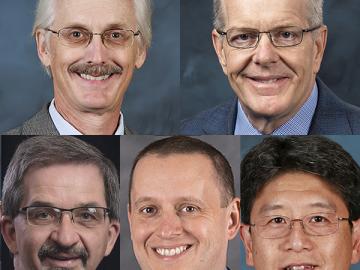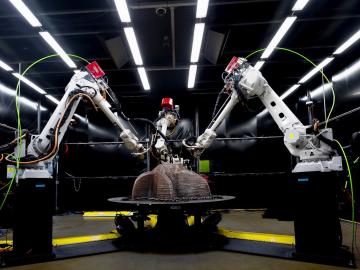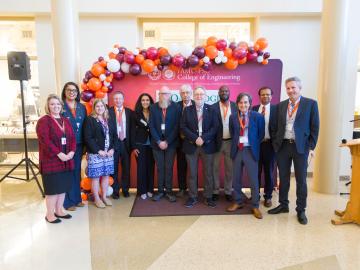
Filter News
Area of Research
- Advanced Manufacturing (13)
- Biological Systems (14)
- Biology and Environment (40)
- Biology and Soft Matter (1)
- Building Technologies (3)
- Chemistry and Physics at Interfaces (4)
- Clean Energy (167)
- Climate and Environmental Systems (2)
- Computational Biology (4)
- Computational Engineering (2)
- Computer Science (4)
- Energy Frontier Research Centers (7)
- Energy Sciences (2)
- Fossil Energy (2)
- Fuel Cycle Science and Technology (1)
- Functional Materials for Energy (6)
- Fusion and Fission (17)
- Fusion Energy (3)
- Geographic Information Science and Technology (2)
- Isotope Development and Production (1)
- Isotopes (8)
- Materials (204)
- Materials Characterization (2)
- Materials for Computing (13)
- Materials Synthesis from Atoms to Systems (5)
- Materials Under Extremes (5)
- National Security (24)
- Neutron Science (77)
- Nuclear Science and Technology (24)
- Nuclear Systems Modeling, Simulation and Validation (1)
- Nuclear Systems Technology (1)
- Quantum Condensed Matter (1)
- Quantum information Science (1)
- Reactor Technology (1)
- Sensors and Controls (1)
- Supercomputing (107)
- Transportation Systems (5)
News Type
Date
News Topics
- 3-D Printing/Advanced Manufacturing (46)
- Advanced Reactors (11)
- Artificial Intelligence (35)
- Big Data (7)
- Bioenergy (23)
- Biology (22)
- Biomedical (17)
- Biotechnology (8)
- Buildings (15)
- Chemical Sciences (32)
- Clean Water (2)
- Climate Change (22)
- Composites (11)
- Computer Science (61)
- Coronavirus (17)
- Critical Materials (11)
- Cybersecurity (17)
- Decarbonization (20)
- Education (3)
- Element Discovery (1)
- Energy Storage (43)
- Environment (36)
- Exascale Computing (10)
- Fossil Energy (1)
- Frontier (15)
- Fusion (17)
- Grid (16)
- High-Performance Computing (30)
- Isotopes (18)
- ITER (2)
- Machine Learning (13)
- Materials (60)
- Materials Science (53)
- Mercury (2)
- Microelectronics (1)
- Microscopy (16)
- Molten Salt (3)
- Nanotechnology (26)
- National Security (18)
- Net Zero (3)
- Neutron Science (52)
- Nuclear Energy (27)
- Partnerships (29)
- Physics (24)
- Polymers (12)
- Quantum Computing (11)
- Quantum Science (28)
- Renewable Energy (1)
- Security (12)
- Simulation (9)
- Space Exploration (3)
- Statistics (1)
- Summit (21)
- Sustainable Energy (30)
- Transformational Challenge Reactor (4)
- Transportation (25)
Media Contacts

The Department of Energy’s Oak Ridge National Laboratory has named five researchers as ORNL Corporate Fellows in recognition of their significant career accomplishments and continued leadership.

The Department of Energy announced a $67 million investment in several AI projects from institutions in both government and academia as part of its AI for Science initiative. Six ORNL-led (or co-led) projects received funding.

A research team led by the Department of Energy’s Oak Ridge National Laboratory has devised a unique method to observe changes in materials at the atomic level. The technique opens new avenues for understanding and developing advanced materials for quantum computing and electronics.

Researchers at ORNL are using advanced manufacturing techniques to revitalize the domestic production of very large metal parts that weigh at least 10,000 pounds each and are necessary for a variety of industries, including clean energy.

Oak Ridge National Laboratory has launched its Neutron Nexus pilot program with Florida Agricultural & Mechanical University and Florida State University through the FAMU-FSU College of Engineering. The first program of its kind nationwide, it’s aimed at broadening and diversifying the scientific user community with outreach to universities and colleges.

Combining two techniques, analytical chemists at the Department of Energy’s Oak Ridge National Laboratory became the first to detect fluorine and different isotopes of uranium in a single particle at the same time.

A new technology to continuously place individual atoms exactly where they are needed could lead to new materials for devices that address critical needs for the field of quantum computing and communication that cannot be produced by conventional means.

A study led by the Department of Energy’s Oak Ridge National Laboratory details how artificial intelligence researchers created an AI model to help identify new alloys used as shielding for housing fusion applications components in a nuclear reactor. The findings mark a major step towards improving nuclear fusion facilities.

A new technical collaboration program at the Department of Energy’s Oak Ridge National Laboratory will help businesses develop and launch electric grid innovations. Sponsored by the Transformer Resilience and Advanced Components program in DOE’s Office of Electricity, the initiative will provide companies with access to national laboratory resources, enabling them to capture market opportunities.

U2opia Technology has licensed Situ and Heartbeat, a package of technologies from the Department of Energy’s Oak Ridge National Laboratory that offer a new method for advanced cybersecurity monitoring in real time.


